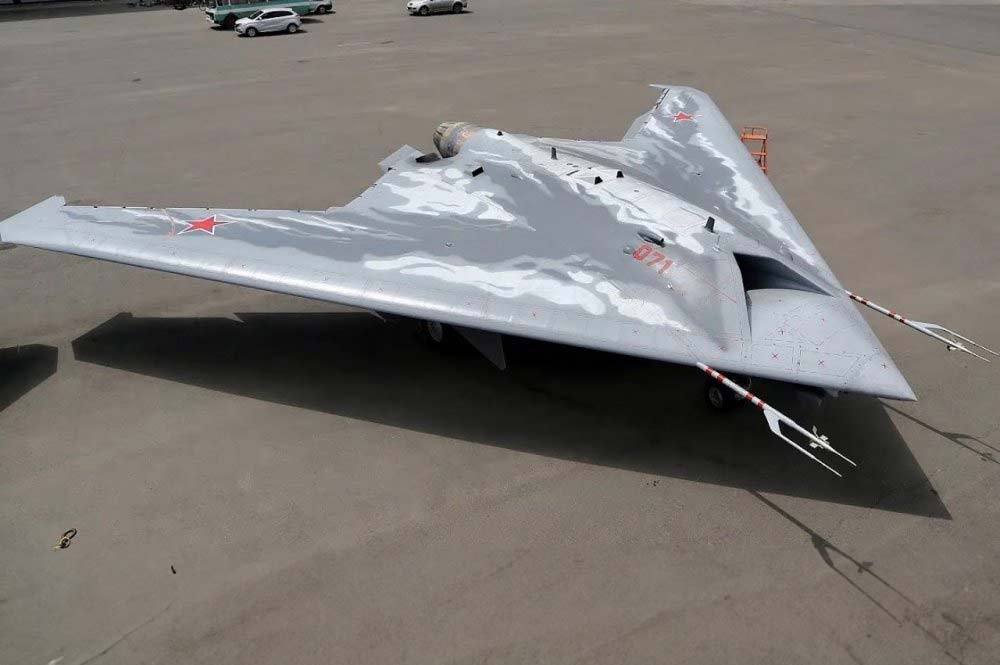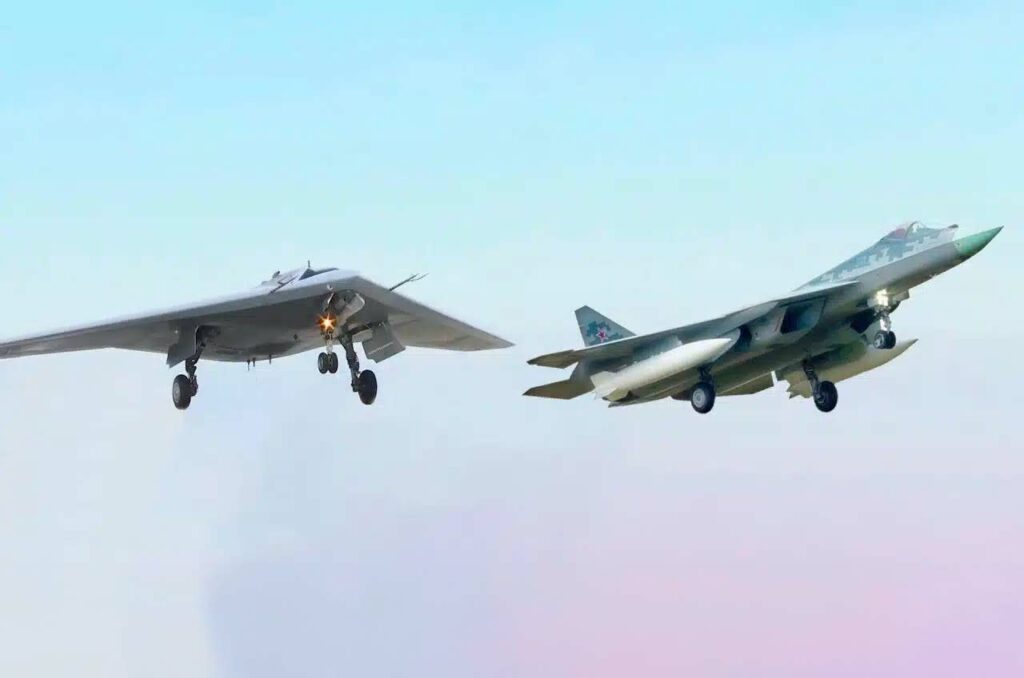The Sukhoi S-70 Okhotnik-B is a Russian stealth unmanned combat aerial vehicle (UCAV) featuring a flying-wing design, AL-31F engine, and internal weapon bays for up to 2,000 kg of munitions.
The Sukhoi S-70 Okhotnik-B, also known as “Hunter-B,” is a Russian stealth heavy unmanned combat aerial vehicle (UCAV) developed by Sukhoi and Russian Aircraft Corporation MiG. It features a flying-wing design with composite materials and stealth coatings to minimize radar cross-section. Powered by a single AL-31F turbofan engine, the Okhotnik-B has a maximum takeoff weight of approximately 20,000 kg (44,092 lbs) and a wingspan of 20 meters (65 ft 7 in). It can reach speeds up to 1,000 km/h (621 mph) and operates at altitudes up to 12,000 meters (39,370 ft). The UCAV is equipped with internal weapon bays capable of carrying up to 2,000 kg (4,409 lbs) of guided and unguided munitions, including air-to-surface missiles and precision-guided bombs. Its advanced sensor suite comprises electro-optical/infrared sensors, synthetic aperture radar, and electronic intelligence systems, enabling detailed reconnaissance and target acquisition. The Okhotnik-B is designed to operate autonomously or in conjunction with manned aircraft like the Su-57, extending the capabilities of Russia’s aerial combat operations.
History of the Development of the Sukhoi S-70 Okhotnik (Hunter)
In the early 2010s, the global military landscape witnessed a growing emphasis on unmanned systems capable of performing complex combat and reconnaissance missions. Recognizing the strategic advantages of such platforms, the Russian Ministry of Defense initiated a program to develop a heavy unmanned combat aerial vehicle (UCAV) that could operate in contested environments while minimizing risks to human pilots.
In 2011, Sukhoi was selected to lead this ambitious project, building upon prior work from the Mikoyan Skat UCAV program. The objective was to create a sixth-generation unmanned platform that could complement manned aircraft, particularly the Su-57 fighter jet, in various operational scenarios. The development aimed to achieve a stealthy design with advanced reconnaissance and strike capabilities, ensuring interoperability with existing and future aerial assets.
By 2014, the first mock-up intended for ground tests was completed, marking a significant milestone in the project’s progression. In July 2017, the prototype was publicly revealed, showcasing its flying-wing configuration—a design choice aimed at enhancing aerodynamic efficiency and reducing radar cross-section.
The Okhotnik-B underwent a series of rigorous tests to validate its systems and performance parameters. In November 2018, it performed autonomous taxiing, speeding, and stopping tests at the Novosibirsk Aircraft Production Association’s runway, reaching speeds up to 200 km/h (124 mph). These tests were crucial in assessing the UCAV’s ground handling and control systems.
On August 3, 2019, the Okhotnik-B achieved its maiden flight, lasting approximately 20 minutes and reaching an altitude of 600 meters (1,969 ft) over the Chkalov State Flight Test Center in Akhtubinsk. This successful flight demonstrated the basic aerodynamic and control characteristics of the UCAV.
Subsequent tests focused on integrating the Okhotnik-B with manned platforms. Notably, on September 27, 2019, the UCAV flew alongside a Su-57 fighter jet for over 30 minutes, testing the extension of the fighter’s radar and target designation range. This collaboration aimed to enable the use of long-range air-launched weapons from outside enemy air defenses, highlighting the UCAV’s role as a force multiplier in network-centric warfare.
The development of the Okhotnik-B reflects Russia’s strategic intent to enhance its aerial combat capabilities through advanced unmanned systems. By leveraging stealth technology, autonomous operations, and seamless integration with manned aircraft, the Okhotnik-B is poised to play a pivotal role in future military operations, aligning with global trends toward increased use of unmanned platforms in complex combat scenarios.

Design of the Sukhoi S-70 Okhotnik (Hunter)
The Sukhoi S-70 Okhotnik-B features a flying-wing, tailless design optimized for stealth. Its airframe is constructed from composite materials and coated with radar-absorbent substances, significantly reducing its radar cross-section and enhancing its survivability in contested environments. The flying-wing configuration not only contributes to its low observability but also provides aerodynamic efficiency and increased internal volume for payloads.
The UCAV measures approximately 14 meters (46 ft) in length, with a wingspan of around 19 meters (62 ft). This sizable platform allows for substantial internal storage, enabling the carriage of weapons and sensors within internal bays to maintain its stealth characteristics. The internal bays can accommodate up to 2,000 kg (4,409 lbs) of guided and unguided munitions, including air-to-surface missiles and precision-guided bombs.
Powering the Okhotnik-B is a single AL-31F turbofan engine, derived from the Su-27 fighter aircraft. This engine choice provides a balance between performance and reliability. The UCAV’s maximum speed is approximately 1,000 km/h (621 mph), allowing it to rapidly ingress and egress from target areas. The operational ceiling is around 12,000 meters (39,370 ft), positioning it above the effective range of many ground-based air defense systems.
The Sukhoi S-70 Okhotnik-B is equipped with an advanced avionics suite, incorporating electro-optical/infrared (EO/IR) sensors, synthetic aperture radar (SAR), and electronic intelligence (ELINT) systems. These components allow the UCAV to conduct real-time surveillance, target acquisition, and battle damage assessment. Its sensor fusion and data-link capabilities enable seamless integration with other airborne and ground-based assets, significantly enhancing situational awareness.
One of the critical design elements is the engine exhaust configuration. The initial prototype featured an AL-31F turbofan engine with a conventional exhaust nozzle, which increases infrared and radar signature. However, later iterations incorporate a more stealth-optimized design, with a serrated exhaust nozzle and infrared suppression systems to reduce detection risk from enemy infrared search and track (IRST) systems.
The Okhotnik-B’s autonomous control systems are developed to support both independent operations and cooperative engagement with manned aircraft, particularly the Sukhoi Su-57 fifth-generation fighter. This manned-unmanned teaming (MUM-T) capability allows the UCAV to extend the reach of manned assets, carry out suppression of enemy air defenses (SEAD) missions, and serve as a forward sensor node in complex operational environments.
Despite its advantages, the Okhotnik-B has several limitations. The lack of a fully enclosed engine exhaust in early prototypes compromises stealth capabilities compared to Western counterparts such as the Northrop Grumman X-47B or Boeing MQ-25 Stingray. Additionally, the absence of high-thrust vectoring or supercruise capability means the Okhotnik-B relies on subsonic speeds, reducing its ability to evade high-speed threats. However, these trade-offs align with its intended mission of stealthy, long-endurance operations rather than direct aerial combat.
Performance of the Sukhoi S-70 Okhotnik (Hunter)
The Sukhoi S-70 Okhotnik-B is powered by a single Saturn AL-31F turbofan engine, which produces 123 kN (27,600 lbf) of thrust. This powerplant enables the UCAV to reach a maximum speed of 1,000 km/h (621 mph) and operate at an altitude of up to 12,000 meters (39,370 ft). The aircraft’s operational range is estimated at 6,000 km (3,728 miles), with an endurance exceeding 24 hours, making it suitable for long-range reconnaissance and strike missions.
The aircraft has an internal weapons bay capable of carrying up to 2,000 kg (4,409 lbs) of ordnance, ensuring it maintains a low radar cross-section (RCS). Armament options include Kh-59MK2 cruise missiles, KAB-500S-E guided bombs, and air-to-ground missiles, allowing it to perform precision strikes against high-value targets.
In comparison to other unmanned combat aerial vehicles (UCAVs), the Okhotnik-B offers superior endurance and payload capacity over the Boeing MQ-25 Stingray but lacks the high-speed capability of the Northrop Grumman RQ-180. However, its primary advantage is its stealth and MUM-T integration, which provides enhanced operational flexibility when deployed alongside manned fighter aircraft like the Su-57.

Variants of the Sukhoi S-70 Okhotnik (Hunter)
The Okhotnik program currently focuses on two primary development iterations:
- Okhotnik-B (Baseline Variant) – The first prototype, featuring a conventional exhaust nozzle and an AL-31F engine, focused on flight testing and sensor integration. This variant lacks optimized stealth engine exhaust and is primarily used for evaluation and refinement.
- Okhotnik Advanced Variant – A refined version featuring an infrared-suppressed exhaust system, upgraded avionics, and enhanced sensor integration. This variant is designed for operational deployment and manned-unmanned teaming (MUM-T) missions alongside Su-57 fighters.
Further developments may include future engine upgrades, additional electronic warfare (EW) capabilities, and satellite-controlled operation enhancements.
Military Use and Combat of the Sukhoi S-70 Okhotnik (Hunter)
The Sukhoi S-70 Okhotnik-B is envisioned as a force multiplier for Russia’s tactical and strategic airpower, operating both autonomously and as part of a network-centric warfare environment. Its primary roles include:
- Intelligence, surveillance, and reconnaissance (ISR) – Utilizing SAR, ELINT, and EO/IR sensors to conduct battlefield intelligence gathering and reconnaissance missions.
- Precision strike capability – Deploying guided munitions for strategic air-to-ground and suppression of enemy air defenses (SEAD) missions.
- Electronic warfare (EW) support – Assisting in jamming and electronic countermeasure operations to degrade enemy air defenses.
- Manned-unmanned teaming (MUM-T) operations – Acting as an extended sensor and strike asset for Su-57 fighter jets.
As of 2024, the Okhotnik-B has been undergoing extensive flight testing and system integration. There are unconfirmed reports suggesting limited operational trials in Ukraine, where Russian forces have been exploring the use of advanced UCAVs for ISR and limited strike operations. However, these claims remain speculative due to the classified nature of Russian military operations.
Regarding export potential, Russia has not officially announced foreign sales of the Okhotnik-B, although it is expected that potential buyers could include India and other defense partners seeking advanced UCAV technology.
The Sukhoi S-70 Okhotnik-B represents Russia’s entry into the stealth UCAV domain, combining stealth characteristics, extended endurance, and a substantial payload capacity. It provides an autonomous strike capability while also integrating with manned fighter aircraft, particularly the Su-57, to enhance operational reach and flexibility. While it faces challenges in stealth optimization and propulsion efficiency, ongoing refinements aim to address these limitations.
The Okhotnik-B is expected to enter full operational service with the Russian Aerospace Forces by 2025, marking a significant step in Russia’s development of next-generation combat aviation systems. Its effectiveness in actual combat scenarios will depend on continued upgrades, strategic deployment, and integration within the broader Russian air defense network.
Back to the Drones, UAVs, UCAVs page